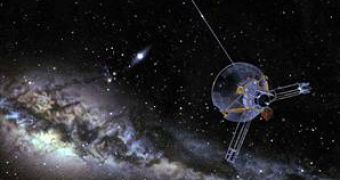The US Pioneer program of unmanned space missions was designed for planetary exploration. There were a number of such missions in the program, but the most notable were Pioneer 10 and Pioneer 11, which explored the outer planets and left the solar system. Both carry a golden plaque, depicting a man and a woman and information about the origin and the creators of the probes, should any extraterrestrials find them someday.
Launched in 1972 and 1973, Pioneer 10 and 11 are both billions of miles from Earth as they zoom out of the solar system in opposite directions, and as of February 6, Pioneer 10 was about 92.12 astronomical units (AU) from the sun and headed towards the constellation Taurus. One AU is the distance between the Earth and sun, or about 93 million miles (150 million kilometers).
It's been years since NASA last heard from either of its two Pioneer probes hurtling out of the solar system, but scientists are still debating the source of an odd force pushing against the outbound spacecraft.
When all known forces acting on the spacecraft are taken into consideration, a very small but unexplained force remains, dubbed the Pioneer Anomaly, that causes a constant sunward acceleration of both spacecraft.
Whether that force stems from the probes themselves, something exotic like, dark matter or some new facet of physics or gravity, is still a much debated subject.
The effect is so small that it could even be a statistical anomaly caused by differences in the way data was collected over the lifetime of the probes. Numerous changes were made over this period, including changes in the receiving instruments, reception sites, data recording systems and recording formats.
One of the more common causes could be the fact that heat from Pioneer probes' electronics or two nuclear power sources - known as radioisotope thermal generators (RTGs) - could be emitting infrared photons that then smack into the spacecraft's dish-like main antenna, causing a recoil effect that Slava Turyshev likened to sunlight striking a solar sail.
The Pioneer Explorer Collaboration is expecting to address this concern around June 2007, in what is hoped to be a conclusion to this faraway mystery.
"I would like to see this story reach its finality," said Turyshev, an astrophysicist with NASA's Jet Propulsion Laboratory (JPL) who has spent the last 14 years-some of it on his own time-studying the Pioneer Anomaly. "So if it's conventional physics, that's fine and we can all go about our daily business. But if it's something else, there may be another page."

 14 DAY TRIAL //
14 DAY TRIAL //